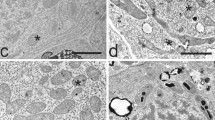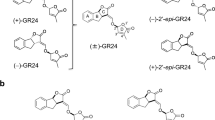Abstract
Most fungi are known to synthesize siderophores under iron limitation. However, arbuscular mycorrhizal fungi (AM fungi) have so far not been reported to produce siderophores, although their metabolism is iron-dependent. In an approach to isolate siderophores from AM fungi, we have grown plants of Tagetes patula nana in the presence of spores from AM fungi of the genus Glomus (G. etunicatum, G. mossae & unidentified Glomus sp.) symbiotically under iron limitation and sterile conditions. A siderophore was isolated from infected roots after 2–3 weeks of growth in pots containing low-iron sand with Hoagland solution. HPLC analysis of the root cell lysate revealed a peak at a retention time of 6.7 min which showed iron-binding properties in a chrome azurol S test. The compound was isolated by preparative HPLC and the structure was determined by high resolution electrospray FTICR-MS and GC/MS analysis of the hydrolysis products. From an observed absolute mass to charge ratio (m/z) of 401.11925 [M+H]+ with a relative mass error of ∆ = 0.47 ppm an elemental composition of C16H21N2O10 [M+H]+ was derived, suggesting a molecular weight of 400 Da for glomuferrin. Corresponnding ion masses of m/z 423.10 and m/z 439.06 were asigned to the Na-adduct and K-adduct respectively. A mass of 455.03836 confirmed an Fe- complex with an elemental composition of C16H19N2O10Fe (∆ = 0.15 ppm). GC/MS analysis of the HCl lysate (6 N HCL, 12 h) revealed 1,4 butanediamine. Thus the proposed structure of the isolated siderophore from Glomus species consisted of 1,4 butanediamine amidically linked to two dehydrated citrate residues, similar to the previously identified bis-amidorhizoferrin. Thus, the isolated siderophore (glomuferrin) is a member of the rhizoferrin family previously isolated from fungi of the Mucorales (Zygomycetes).





Similar content being viewed by others
References
Carrano CJ, Drechsel H, Kaiser D, Jung G, Matzanke B, Winkelmann G, Rochel N, Albrecht-Gary A (1996) Coordination chemistry of the carboxylate type siderophore rhizoferrin: the iron(III) complex and its metal analogs. Inorg Chem 35:6429–6436
Drechsel H, Metzger J, Freund S, Jung G, Boelaert JR, Winkelmann G (1991) Rhizoferrin—a novel siderophore from the fungus Rhizopus microsporus var. rhizopodiformis. Biometals 4:238–243
Drechsel H, Jung G, Winkelmann G (1992) Stereochemical characterization of rhizoferrin and identification of its dehydration products. Biometals 5:141–148
Drechsel H, Tschierske M, Thieken A, Jung G, Zähner H, Winkelmann G (1995) The carboxylate type siderophore rhizoferrin and its analogs produced by directed fermentation. J Ind Microbiol 14:105–112
Fernandez V, Winkelmann G (2005) The determination of ferric iron in plants by HPC using the microbial iron chelator desferrioxamine E. Biometals 18:53–62
Grace C, Stribley DP (1991) A safer procedure for root staining of vesicular arbuscular mycorrhizal fungi. Mycol Res 95:1160–1162
Haselwandter K, Winkelmann G (2002) Ferricrocin—an ectomycorrhizal siderophore of Cenococcum geophilum. Biometals 15:73–77
Haselwandter K, Winkelmann G (2007) Siderophores of symbiotic fungi. In: Varma A, Chincholkar SB (eds) Soil biology, vol 12. Springer, Berlin
Haselwandter K, Dobernigg B, Beck W, Jung G, Cansier A, Winkelmann G (1992) Isolation and identification of hydroxamate siderophores of ericoid mycorrhizal fungi. Biometals 5:51–56
Haselwandter K, Passler V, Reiter S, Schmid DG, Nicholson G, Hentschlel P, Albert K, Winkelmann G (2006) Basidiochrome—a novel siderophore of the orcidaceous mycorrhizal fungi Ceratobasidium and Rhizoctonia spp. BioMetals 19:335–343
Matzanke BF, Bill E, Trautwein AX, Winkelmann G (1987) Role of siderophores in iron storage in spores of Neurospora crassa and Aspergillus ochraceus. J Bacteriol. 169:5873–5876
Patil BB, Wakharkar RD, Chincholkar SB (1999) Siderophores of Cunninghamella blakesleana NCIM 687. World J Microbiol Biotechnol 15:265–268
Prabhu V, Biolchini PF, Boyer GL (1996) Detection and identification of ferricrocin produced by ectendomycorrhizal fungi in the genus Wilcoxina. Biometals 9:229–234
Schrettl M, Winkelmann G, Haas H (2004) Ferrichrome in Schizosaccharomyces pombe—an iron transport and iron storage compound. Biometals 17:647–654
Schüßler A, Schwarzott D, Walker C (2001) A new fungal phylum, the Glomeromycota: phylogeny and evolution. Mycol Res 105:1413–1421
Schwyn B, Neilands JB (1987) Universal chemical assay for the detection and determination of siderophores. Anal Biochem 160:47–56
Smith SE, Read DJ (1997) Mycorrhizal Symbiosis. Academic Press, San Diego
Thieken A, Winkelmann G (1992) Rhizoferrin: a complexone type siderophore of the Mucorales and Entomophthorales (Zygomycetes). FEMS Microbiol Lett 94:37–41
Van der Helm D, Winkelmann G (1994) Hydroxamate and polycarboxylates as iron transport agents (siderophores) in fungi. In: Winkelmann G, Winge DR (eds) Metal ions in Fungi. Marcel Dekker, New York
Winkelmann G (1992) Structures and functions of fungal siderophores containing hydroxamate and complexone type iron binding ligands. Mycol Res 96:529–534
Winkelmann G (2001) Siderophore transport in fungi. In: Winkelmann G (ed) Microbial transport systems. Wiley -VCH, Weinheim, pp 463–497
Winkelmann G (2002) Microbial siderophore-mediated transport. Biochem Soc Trans 30:691–696
Winkelmann G, Drechsel H (1997) Microbial Siderophores. In: Rehm H-J, Reed G (eds) Biotechnology, vol 7, 2nd edn. VCH Chemie, Weinheim, pp 199–246
Wubet T (2004) Personal communication
Acknowledgements
We thank T. Wubet for provideing the Glomus spores, I Kottke for help in the Glomus biology, G. Nicholson and A. Kulik for GC/MS-analysis and MS –analysis and Prof. Rolf Reuter for assistence in performing the FM CLSM analysis. Usha Kalidindi from from the Division of Fruits and Horticulture Technology, Indian Agricultural Research Institute, New Delhi-110012 helped in the isolation procedures during a Grant for 3 months within the International Scientific exchange programme of Indian National Science Academy (INSA), New Delhi, and the DFG (Bonn, Germany).
Author information
Authors and Affiliations
Corresponding author
Rights and permissions
About this article
Cite this article
Winkelmann, G. A search for glomuferrin: a potential siderophore of arbuscular mycorrhizal fungi of the genus Glomus . Biometals 30, 559–564 (2017). https://doi.org/10.1007/s10534-017-0026-x
Received:
Accepted:
Published:
Issue Date:
DOI: https://doi.org/10.1007/s10534-017-0026-x




